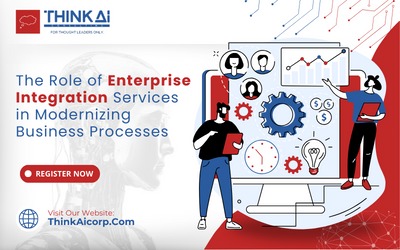In the current era of cut-throat competition, remaining competitive is difficult. Due to the advent of high-end technology, competition not only limits itself to offering high-end products to your target clientele but also includes maintaining efficiency, seamless integration across all facets of operations, and adaptability to up-and-coming trends.
The digital era has taken over the business landscape, meaning data has become extremely important. Due to this prospect, Enterprise Integration Services (EIS)’s role has become essential in modernizing business processes.
This blog will help look into the pivotal role played by EIS in upgrading business processes.
Enterprise Integration Services (EIS) primarily refer to technologies, tools, and practices that facilitate the seamless flow of data and processes across disparate systems within an organization. By integrating different applications and systems, Enterprise Integration Services can help your enterprise streamline operations, improve collaboration, and enhance agility.
Data integration services
One of the primary responsibilities of EIS is data integration. This prospect involves consolidating data from different sources, structures, and formats into a unified view. Doing this equips enterprises to break down data and create a single source of truth, which makes the decision-making process more manageable.
It also helps create a centralized data repository comprising sales data, customer information, and inventory levels. In addition, it equips an organization to maintain consistency and accuracy throughout all their operations and successfully function within their chosen industry.
Real-time connectivity
Accessing real-time data in today’s fast-paced business landscape is paramount as it helps make informed decisions. An organization can access real-time data by maintaining real-time connectivity between disparate systems. This prospect equips organizations to exchange data instantly and synchronize it efficiently.
This accessibility to real-time data and visibility into critical metrics equips organizations to make informed decisions that allow them to compete efficiently within their chosen industries. Furthermore, with the help of EIS, decision-makers within an organization can receive actionable insights that equip them to make prompt decisions regarding market changes and customer demands.
Process automation
One of the most important aspects of a business is its operations. EIS helps process automation by orchestrating workflows across various systems and applications. Repetitive tasks are automated efficiently, opening up valuable time for employees and enabling them to focus on more strategic initiatives to help the organization flourish. With the help of process automation, EIS equips organizations to automate operations such as order processing, inventory management, and invoice generation. This practice helps create operational efficiency within the organization and reduces manual errors.
Scalability and flexibility
With the advent of high-end technology, businesses need to be flexible and embrace scalability. With the help of EIS, scalability and flexibility have become accessible for companies. EIS enables enterprises to adapt to the changing requirements within the market and embrace new systems and applications seamlessly.
With the help of the enterprise integration strategy, enterprises can expand into new markets, integrate with third-party vendors, and introduce new product lines to their customers, eventually contributing to the foundation for scalable growth. EIS contributes to an enterprise being flexible in its approach towards adaptability and eventually scaling its growth to flourish in its chosen purpose and compete effectively with its fellow competitors.
Enhancing customer experience
To compete efficiently within your chosen industry, your organization will have to win over its target clientele. A personalized customer experience would help drive customer satisfaction and loyalty. With the help of the enterprise integration strategy, enterprises can integrate customer data from various touchpoints, such as social media platforms, websites, and mobile apps.
This information helps seek a holistic view of the customer journey, which equips businesses to deliver tailored experiences, personalized recommendations, and a unique customer experience. With the help of EIS, your business will be able to anticipate the needs of your target clientele and provide proactive support so that you can win their trust and loyalty and efficiently flourish in your chosen market.
Security and Compliance
With the evolution of the digital age comes the responsibility for data privacy. Data privacy regulations have become increasingly stringent. As an organization, ensuring security and compliance is pivotal. With the help of EIS, your enterprise can embrace a robust security measure to safeguard sensitive data and ensure regulatory compliance.
With the help of EIS, you can adopt security measures such as encryption access controls, audit trails, and compliance reporting. EIS would help you mitigate security risks and maintain data integrity, allowing you to keep the personal information shared by our clientele safe. This practice will equip you to earn a positive reputation within your chosen industry and successfully gain the trust and loyalty of your target clientele.
Conclusion
By driving efficiency and fostering agility, EIS can help empower your enterprise to stay competitive in today’s digital landscape. In the current competitive business landscape, investing in robust EIS solutions can help you seek new opportunities and drive sustainable growth to compete with competitors.

